Weather satellite equipment(APT,HRPT,Meteosat,Eumetcast)
1. Prime focus dish and helical feed for 1700 MHz

e.g.: D = 1.2 m T = 205 mm
focal distance F = D*D / 16 /T = 1.2
* 1.2 / 16/ 0.205 = 439 mm
F/D
= 439 / 1200 = 0.365
gain in dB G = 10 log10 [ (D * 3.1415 / wavelength) ^² * efficiency] =
=
10 log10 [ (1.2 * 3.1415 / 0.1765) ^² * 0.55 ] = 24 dB or 251
dish beamwidth =
200 / (gain) ^ 0.5 = 200 / 251 ^ 0.5 = 12.6 degrees
I found that the focal
point should be at the reflector or inside of the first winding.
See also the online microwave antenna handbook PaulW1GHZ.
2. My homemade helical feed for a prime focus dish
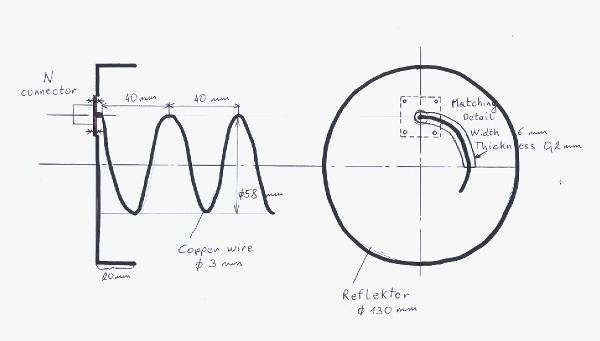
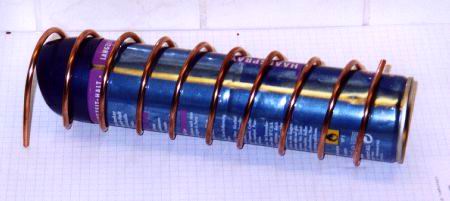


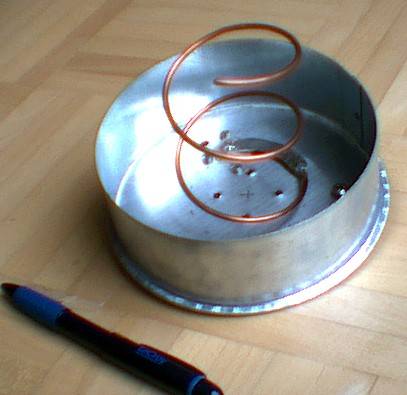
If F/D is lower than 0.4 you should use 2.5 turns otherwise 3 to 3.5 turns are perfect. As reflector
I used a stove-pipe cap with a diameter of 135 mm and copper wire about 2.7 - 3.3 mm in diameter (6 -10 mm^2 earthing wire) is used to wind the helix. Wind some turns around a
50 mm diameter form. The turns are wound counterclockwise. The helix will spring out to about 58 mm when winding is complete. Now carefully
stretch it so that the turns are spaced 40 mm. Cut off the first half turn and the end to get the required turns. The matching strip (brass)
matching the curvature of the first quarter turn of the helix. Using a large soldering iron solder the brass strip to the first 1/4 turn. The strip
should be 2 mm above the reflector at its start ( at the N connector), the distance at the end right at the highest signal level of the satellite.
Costs
of the helix with N connector about 12 Euro.
3. Offset dish and helical feed for 1700 MHz
1. My homemade helical feed for an offset dish
If you want to use an offset dish then make a helical with up to 7 turns but spacing between each turn
should be about 20 mm.
80 cm Offset dish (81 cm x 72 cm) with about 20.5 dB gain costs about 25 Euro (Conrad
eletronic shop in Germany, Austria). The dish was turned by 90 degrees.


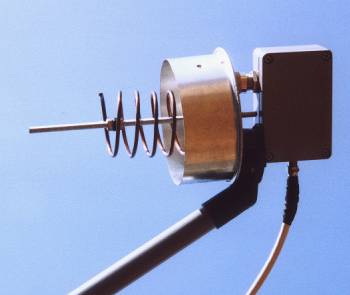

Now I use a Gibertini 1 m x 0.94 m offset dish (costs about 55 Euro) with this
helical feed. The Gibertini has a better dish efficiency (up to 70 %) with
a gain of 23 db. This means higher signalpower from Noaa 15 and Noaa 17.
This dish is mounted like a normal TV sat dish.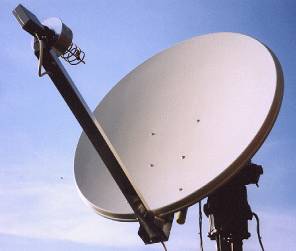

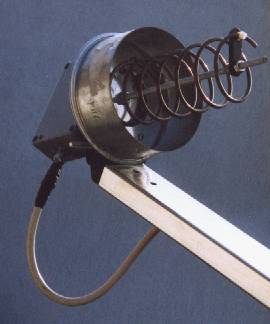
2. QFH (quadrifilar helix) for APT 137 MHz
My QFH APT antenna is a Bill Sykes/Bob Cobey (RIG 48, page 17) design and calculated with Bob Thorp's qfh.zip software (RIG 53, page 68).
Circular + vertical polar diagram can be seen in RIG48, page 19.

You
need 1m waste pipe 40 mm in diameter plus 1 waste pipe plug at the top of the boom. About 5.5 m copper tube (8 - 12 mm diameter central heating tube)
plus 8 elbows (90 degree, short design) -> I prefer soft copper because
it is easier to wind. RG58 co-axial cable for balun and feed. Flux and a gas torch to solder all copper tubes and elbows.
Costs about 10 Euro.
At
first start qfh.exe and insert all requested parameters. Cut all tubes as given from qfh.exe. Drill all holes into the boom and then wind the helix
as shown (IMPORTANT: anti-clockwise seen from top). There is a small and a large loop and at the top all 4 ends are open. Connect one large loop
and one small loop as shown above with the RG58 shield and the other end of the large and small loop with RG58. The balun is 4 turn RG58 around the boom.
4. 137 MHz preamplifier
I use a 1.5 dB NF/ 30 dB gain ready built preamplifier from "nuova elettronica" to overcome feedline loss.
5. APT receiver(137 MHz)
Nuova elettronica
APT receiver kit LX.1375: costs about 210 Euro in the year 2000
- Signal level meter
- Frequency display
-
AFC
- Suitable for Meteosat and Polar
- Frequency scan from 134 - 139 MHz
- Tuneable
frequency from 134 - 139 MHz (100, 10 or 1 kHz steps)
- 8 programable frequency memories
- channel scan
mode
- preamplifier power supply via co-ax cable
- easy to build
6. 1700 MHz Low noise amplifier
I built the Sam Elsdon LNA (from RIG shop and RIG 64)
This LNA is in a waterproof box to connect it directly to the helical feed and has a gain of 32 dB and 0.5 dB NF. Powersupply is done via co-ax cable
coming from the receiver. Costs about 74 Euro in the year 2002.

7. Downconverter 1700 MHz to 137 MHz
I use the RIG/Timestep downconverter from the RIG shop (RIG 59): costs about 153 Euro in the year 2000
- 2 dB NF
-
33 dB gain
- Power input range 6 - 16 V
- Current 40 mA
- 1691.0 MHz input -> 137.5
MHz output
- 1694.5 MHz input -> 137.5 MHz output channel 2 selected
- Switching method
channel 1 at 10 - 16 V, channel 2 selected at 6 -9 V supply
- Power input via co-ax feed or 2.1 DV jack on unit
-
Power output 50 mA at the N socket (can be disabled) for preamplifier

8. HRPT receiver
Nuova elettronica (italy) HRPT
receiver LX.1495: costs about 207 Euro in the year 2002
- tuneable from 135 -155 Mhz
- frequency
steps: 1 kHz, 10 kHz and 100 kHz
- 4 programmable frequency memories
-
channel scan mode
- frequency scan mode (135 - 155 MHz)
- AFC and S-meter
- BNC
input, 2 outputs (decoder and/or oszi)
- power supply via BNC input to the
downconverter
- ready built and adjusted
The receiver is also for CHRPT with Alblas decoder and a 1.2m dish (but not so good as HRPT).
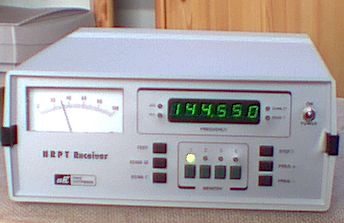
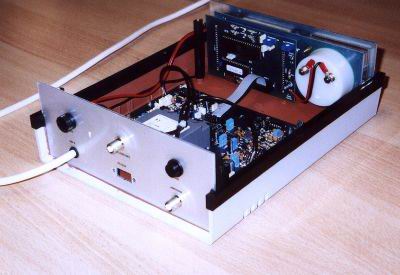
Notice the brown Cu shield lacquer (grounded to earth) inside the plastic box which
I made.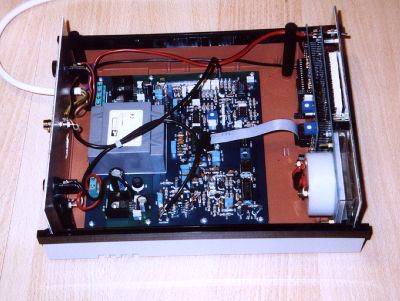
For usage with Alblas decoder insert between receiver output and decoder input
a comparator (e.g. LM311) or a Schmittrigger with a low pass filter. ATTENTION:
Receiver output has inverted signal output and so please connect pin 9 to pin 10 of CON2 at the Alblas decoder if
you use a comparator ( BUT NO connection pin9/10 with the schmittrigger).
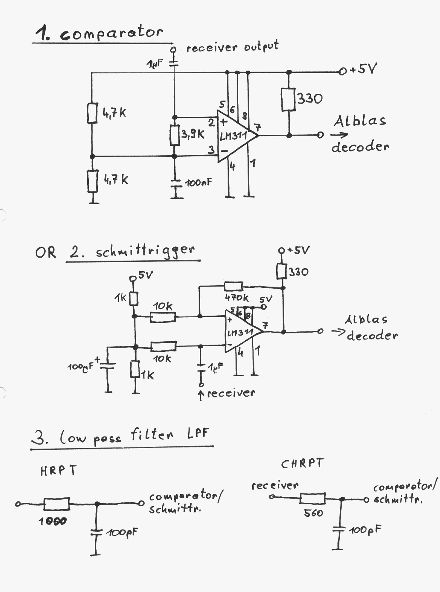
9. HRPT decoder
There are 2 types of decoder, the analog decoder and the digital decoder. To connect a digital decoder to a receiver
you have to insert a comparator between receiver and decoder. The big advantage of an analog decoder is its up to 3 db better performance and that means
smaller antennas (e.g. 85 cm instead 120 cm dish). For Rob Alblas decoder there is an updated EPROM program with a "bit integration and dump"
function available to get a nearly analog decoder performance.
1. Nuova elettronica (italy) HRPT
decoder interface LX.1497: costs about 73 Euro in the year 2002
- ready built digital decoder and I think it is an update of NOAA95 decoder
(including DOS receiving software of the NOAA95 project)
- ISA PC card
-
8 bit Data
- only HRPT decoder
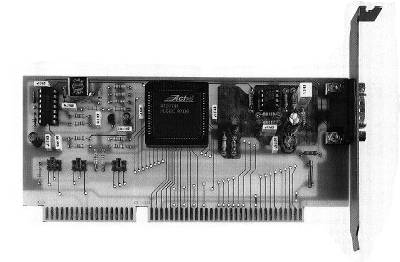
Since March 2008 there is an USB
interface and software for this decoder from Nuova elettronica available.
2. NOAA95 project (italy): SOLD OUT
- kit, digital decoder, DOS
receiving software
- 10.7 MHz IF PC card input from a suitable receiver or modified to use only
the decoder
- ISA PC card
- 8 bit Data
- decoder for HRPT and after modification for CHRPT
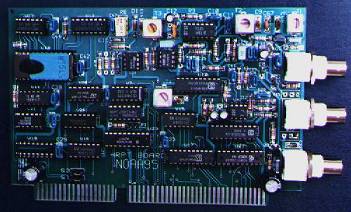
3. Rob Alblas decoder (kit) plus
wsat software: decoder costs about 100 Euro in the year 2002
- digital decoder
- parallel connection to PC
-
10 bit Data
- HRPT, CHRPT, HRI
- DOS and windows receiving software
I built it inside the N.E. receiver
and the small platine is a signal comparator (LM311) with a low pass filter (switchable from HRPT 1.5 MHz to CHRPT 3 MHz bandwidth).
Rob Alblas has a modified
EPROM version with a "bit integration and dump" function for less speckles with HRPT. It is working with the N.E. HRPT receiver.
Until now I got a 2 db better performance and that means I can now use a 85 cm instead of a 120 cm dish (at almost same performance).

10. Meteosat Second Generation System (Eumetcast)
MSG data are broadcasted via Eumetcast service (Hotbird 6 at 13° east) since 2004. I am using my 40 cm offset
dish (19 Euro) with a single universal digital BAFF LNB (with 0.1 dB for 19 Euro). My second LNB is a single universal digital Titanium LNB
(0.2 dB for 14 Euro). As receiver I have the digital skystar USB 1.0 version (about 80 Euro). I got the Eumetcast Client (Tellique software) and an
USB key from Eumetsat after registration for 100 Euro. With this equipment, MSG Manager, AVHRR Manager and Metop Manager (by David Taylor)
it is possible to store HRIT (about 800 MB/h), LRIT (about 191 MB/h), EARS & RSS (about 290 MB/h), AVHRR data, DWDSat data and
Metop data on the harddisk (in sum over 80 GB per day !!!). Image processing is done with GEOSatSignal, MSGAnimator,
HRPT Reader, .... by David Taylor.
The 40 cm dish is mounted on a tripod and the signal-to-noise
ratio is enough (also at rain), about 4.5 to 5 dB with "Server4PC"
technisat software and 40-45 % signal. As I use now a 3.2 GHz CPU with hyper-threading
the skystar needs the driver v4.3.0 (from technisat homepage) to run stable
with hyper-threading.
See more about system and software setup : David
Taylor
Eumetsat USB key and CD Rom
Skystar
receiver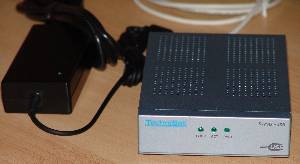
Mobile
MSG system with a 40 cm dish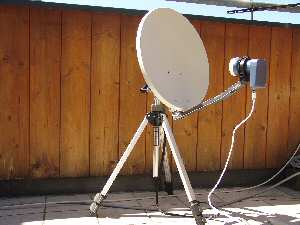
As
data stream is increasing due METOP data, Technisat Skystar USB 1.0 receiver is out of date. Therefore I changed to the Dexatek iTEK DK-5702 DVB-S USB
2.0 box described here
(see under Eumetcast and Vista).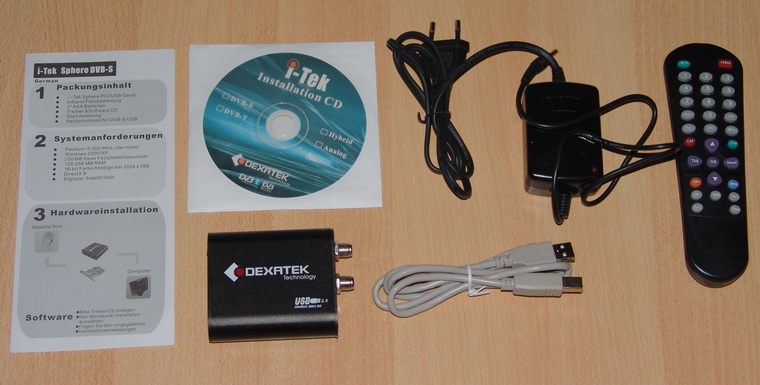
In
2015 Eumetsat/Eumetcast switched from DVB-S to DVB-S2 standard and therefore a DVB-S2 receiver is needed. As I will still use a laptop to save energy
costs I will try the TBS-5925 USB2.0 digital receiver in future.
11. Dish tracking system
1. FodTrack Interface
FodTrack V2.6 is a software +
PC interface to control your G-5500 rotor. The interface is very easy to build which is switched between the rotor controller and the PC (parallel
port). Costs of the interface about 22 Euro (yaer 2002). Also WxTrack by David Taylor is able to control the FodTrack interface. The switch below is useful to
stop immediately automatic tracking.
2. Rotor G-5500:
costs about 950 Euro in the year 2002


Equipment for APT
(stopped 2004):
Click here for APT images with WXSAT and SATSIGNAL
- Receiver LX1375 kit from "nuova elettronica" in italy
- Home-made
QFH antenna
- Preamplifier for LEO's (30 dB gain/1.5 dB NF)
- "Newton":
P4 hyper-threading (3.2 GHz/ 2.0 GB RAM/ 250 GB S-ATA
hard disk/XP), two 19" TFT monitors
- some software for decoding the signals with the PC soundcard
Equipment for HRPT (stopped 2004):Click here for HRPT images
- PC card kit "NOAA95"+ software
- Rob
Alblas decoder, digital HRPT, CHRPT and HRI decoder
- Receiver with a 10.7 MHz IF output (at least 3 MHz bandwidth)
to feed the NOAA95 card and the HRPT receiver LX1495
from "nuova elettronica"
- 1.2
m prime focus dish (24 dB gain), 2.5
turn helical feed
- 0.8 m/ 1 m offset antenna (20.5 dB/23
dB gain), 7 turn helical feed
- G-5500 antenna
rotor + FodTrack interface
- RIG LNA kit (Sam Elsdon design)with 0.5 db NF, 35 db
gain
- RIG Downconverter with 2 db NF, 32 dB gain
-
"Newton": P4 hyper-threading (3.2 GHz/ 2.0 GB RAM/ 250 GB S-ATA hard disk/XP), two 19" TFT monitors
Equipment for Eumetcast
(Meteosat 10, Metop, NOAA, DWDSat), (stopped 2015): Click here for Meteosat image
- Dexatek DK-5702 USB 2.0 box (until end of 2014 because Eumetcast switched to DVB-S2 standard) -> will use TBS-5925 USB2.0 receiver in
future
- 0.4 m offset dish
with 0.1 dB BAFF LNB (mobile version) or 1 m offset dish with 0.2 dB Titanium LNB
- "Einstein": i7 quad core for data capture
with MSG Datamanger, Metop Manager, AVHRR Manager by David Taylor